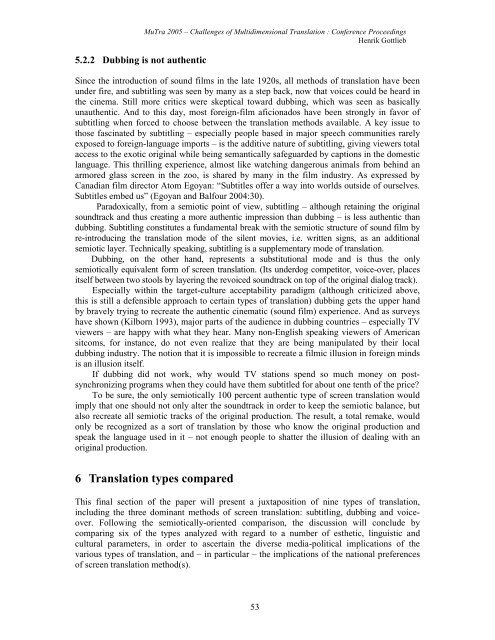Proceedings - Translation Concepts
Proceedings - Translation Concepts
Proceedings - Translation Concepts
Create successful ePaper yourself
Turn your PDF publications into a flip-book with our unique Google optimized e-Paper software.
5.2.2 Dubbing is not authentic<br />
MuTra 2005 – Challenges of Multidimensional <strong>Translation</strong> : Conference <strong>Proceedings</strong><br />
Henrik Gottlieb<br />
Since the introduction of sound films in the late 1920s, all methods of translation have been<br />
under fire, and subtitling was seen by many as a step back, now that voices could be heard in<br />
the cinema. Still more critics were skeptical toward dubbing, which was seen as basically<br />
unauthentic. And to this day, most foreign-film aficionados have been strongly in favor of<br />
subtitling when forced to choose between the translation methods available. A key issue to<br />
those fascinated by subtitling – especially people based in major speech communities rarely<br />
exposed to foreign-language imports – is the additive nature of subtitling, giving viewers total<br />
access to the exotic original while being semantically safeguarded by captions in the domestic<br />
language. This thrilling experience, almost like watching dangerous animals from behind an<br />
armored glass screen in the zoo, is shared by many in the film industry. As expressed by<br />
Canadian film director Atom Egoyan: “Subtitles offer a way into worlds outside of ourselves.<br />
Subtitles embed us” (Egoyan and Balfour 2004:30).<br />
Paradoxically, from a semiotic point of view, subtitling – although retaining the original<br />
soundtrack and thus creating a more authentic impression than dubbing – is less authentic than<br />
dubbing. Subtitling constitutes a fundamental break with the semiotic structure of sound film by<br />
re-introducing the translation mode of the silent movies, i.e. written signs, as an additional<br />
semiotic layer. Technically speaking, subtitling is a supplementary mode of translation.<br />
Dubbing, on the other hand, represents a substitutional mode and is thus the only<br />
semiotically equivalent form of screen translation. (Its underdog competitor, voice-over, places<br />
itself between two stools by layering the revoiced soundtrack on top of the original dialog track).<br />
Especially within the target-culture acceptability paradigm (although criticized above,<br />
this is still a defensible approach to certain types of translation) dubbing gets the upper hand<br />
by bravely trying to recreate the authentic cinematic (sound film) experience. And as surveys<br />
have shown (Kilborn 1993), major parts of the audience in dubbing countries – especially TV<br />
viewers – are happy with what they hear. Many non-English speaking viewers of American<br />
sitcoms, for instance, do not even realize that they are being manipulated by their local<br />
dubbing industry. The notion that it is impossible to recreate a filmic illusion in foreign minds<br />
is an illusion itself.<br />
If dubbing did not work, why would TV stations spend so much money on postsynchronizing<br />
programs when they could have them subtitled for about one tenth of the price?<br />
To be sure, the only semiotically 100 percent authentic type of screen translation would<br />
imply that one should not only alter the soundtrack in order to keep the semiotic balance, but<br />
also recreate all semiotic tracks of the original production. The result, a total remake, would<br />
only be recognized as a sort of translation by those who know the original production and<br />
speak the language used in it – not enough people to shatter the illusion of dealing with an<br />
original production.<br />
6 <strong>Translation</strong> types compared<br />
This final section of the paper will present a juxtaposition of nine types of translation,<br />
including the three dominant methods of screen translation: subtitling, dubbing and voiceover.<br />
Following the semiotically-oriented comparison, the discussion will conclude by<br />
comparing six of the types analyzed with regard to a number of esthetic, linguistic and<br />
cultural parameters, in order to ascertain the diverse media-political implications of the<br />
various types of translation, and – in particular – the implications of the national preferences<br />
of screen translation method(s).<br />
53
















